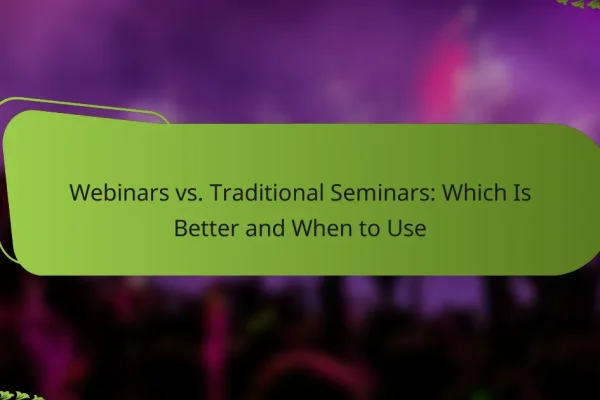How do webinars enhance interactive learning experiences?
Webinars enhance interactive learning experiences by facilitating real-time engagement and collaboration among participants. They create an environment where learners can actively participate, ask questions, and share insights, making the learning process more dynamic and effective.
Engagement through real-time Q&A
Real-time Q&A sessions during webinars allow participants to ask questions and receive immediate feedback from presenters. This interaction not only clarifies doubts but also fosters a sense of community among attendees, encouraging them to engage more deeply with the content.
To maximize engagement, presenters should allocate specific time slots for Q&A and encourage participants to submit questions throughout the session. This approach can significantly enhance the learning experience by addressing individual concerns and interests.
Collaborative tools for participant interaction
Webinars often incorporate collaborative tools such as polls, breakout rooms, and chat features to facilitate participant interaction. These tools enable attendees to share their thoughts and collaborate on tasks, making the learning experience more hands-on and engaging.
For instance, using polls can gauge participant understanding in real-time, while breakout rooms allow smaller groups to discuss topics in depth. Presenters should ensure these tools are easy to use and integrated seamlessly into the webinar platform to encourage maximum participation.
Multimedia content for diverse learning styles
Incorporating multimedia content such as videos, slides, and infographics caters to various learning styles and keeps participants engaged. Visual aids can help clarify complex concepts and make the material more relatable and memorable.
To effectively use multimedia, presenters should balance visual content with verbal explanations. This approach not only reinforces learning but also accommodates different preferences, ensuring that all participants can benefit from the session.
What are the best platforms for hosting webinars?
The best platforms for hosting webinars include Zoom, Webex, and GoToWebinar, each offering unique features that cater to different needs. Choosing the right platform depends on factors like user experience, available features, and integration capabilities.
Zoom for its user-friendly interface
Zoom is widely recognized for its intuitive and easy-to-navigate interface, making it accessible for both hosts and participants. Users can quickly set up webinars with minimal technical expertise, which is ideal for organizations looking to engage audiences without a steep learning curve.
Key features include breakout rooms, polls, and Q&A sessions, enhancing interactivity. Zoom also supports a large number of attendees, often accommodating hundreds to thousands, depending on the plan selected.
Webex for robust features
Webex stands out for its comprehensive set of features designed for professional environments. It offers tools like advanced analytics, customizable branding, and high-quality video and audio options, making it suitable for corporate webinars.
Consider Webex if you need features like real-time translation or integration with other enterprise software. Its ability to host large events with interactive elements can significantly enhance the learning experience.
GoToWebinar for marketing integration
GoToWebinar excels in marketing integration, making it a strong choice for businesses focused on lead generation. It allows users to create registration pages, send automated reminders, and analyze attendee engagement through detailed reports.
This platform is particularly beneficial for marketers looking to track ROI from webinars. With features like customizable emails and follow-up surveys, GoToWebinar helps streamline the entire marketing process, from promotion to post-event analysis.
What are effective strategies for promoting webinars?
Effective strategies for promoting webinars include leveraging social media advertising, utilizing email marketing campaigns, and forming partnerships with influencers. Each method can significantly enhance visibility and attendance rates, ensuring that your webinar reaches a broader audience.
Utilizing social media advertising
Social media advertising is a powerful tool for promoting webinars due to its ability to target specific demographics. Platforms like Facebook, Instagram, and LinkedIn allow you to create tailored ads that reach users based on their interests, location, and behavior.
Consider using eye-catching visuals and compelling copy to attract attention. A/B testing different ad formats can help identify which messages resonate best with your audience, leading to higher engagement and registration rates.
Email marketing campaigns
Email marketing remains one of the most effective ways to promote webinars. Crafting a series of emails that build anticipation can encourage sign-ups and remind potential attendees as the event approaches.
Segment your email list to send personalized invitations based on user interests. Including a clear call-to-action and a simple registration link can streamline the sign-up process, increasing conversion rates significantly.
Partnerships with influencers
Collaborating with influencers can amplify your webinar’s reach and credibility. Influencers can promote your event to their followers, who may already trust their recommendations, leading to higher attendance rates.
Choose influencers whose audience aligns with your target demographic. Providing them with exclusive content or incentives can motivate them to promote your webinar more enthusiastically, enhancing your promotional efforts.
What are the key metrics to evaluate webinar success?
To evaluate webinar success, focus on metrics such as attendance rates, participant engagement, feedback, and conversion rates. These indicators provide insights into how well the webinar met its objectives and the overall effectiveness of the learning experience.
Attendance rates and engagement levels
Attendance rates reflect the percentage of registered participants who actually joined the webinar. A good target is typically around 30-50% of registrants attending live. Engagement levels can be measured through interactions such as polls, Q&A sessions, and chat activity during the event.
To boost attendance, consider sending reminder emails and offering incentives like exclusive content or discounts. For engagement, incorporate interactive elements that encourage participation and keep the audience involved throughout the session.
Participant feedback and satisfaction scores
Gathering participant feedback is crucial for understanding their experience and satisfaction with the webinar. Use post-webinar surveys to assess aspects like content relevance, speaker effectiveness, and overall enjoyment. Aim for a satisfaction score of 80% or higher to indicate a successful event.
Encourage honest feedback by keeping surveys short and offering an option for anonymous responses. Analyze the results to identify strengths and areas for improvement, which can inform future webinars.
Conversion rates for follow-up offers
Conversion rates measure how many attendees took a desired action after the webinar, such as signing up for a course or purchasing a product. A typical conversion rate for webinars can range from 5-20%, depending on the offer and audience alignment.
To enhance conversion rates, clearly communicate the value of your follow-up offers during the webinar. Use urgency and exclusivity in your messaging, such as limited-time discounts or bonuses, to motivate attendees to act promptly.
What prerequisites should be considered for hosting a successful webinar?
To host a successful webinar, consider technical setup, content preparation, and audience targeting. These elements are crucial for ensuring a smooth experience and engaging participants effectively.
Technical setup and equipment
Ensure you have reliable internet connectivity, preferably with a speed of at least 5 Mbps for both upload and download. Use a high-quality microphone and camera to enhance audio and visual clarity, as poor quality can lead to disengagement.
Familiarize yourself with the webinar platform you will use, whether it is Zoom, Webex, or another service. Conduct a test run to check for any technical issues and ensure all features, like screen sharing and chat, function properly.
Content preparation and rehearsal
Develop a clear agenda and outline for your webinar, focusing on key points that resonate with your audience. Create engaging visuals and materials that support your message, such as slides or videos.
Rehearse your presentation multiple times to build confidence and refine your delivery. Consider timing each section to ensure you stay within the allotted time, allowing for questions at the end.
Audience targeting and segmentation
Identify your target audience based on demographics, interests, and professional backgrounds. Tailoring your content to specific segments can significantly enhance engagement and relevance.
Utilize marketing channels like email, social media, and industry forums to reach your audience effectively. Segment your outreach efforts to address the unique needs and preferences of different groups, ensuring your message resonates with each segment.
How do webinars compare to traditional learning methods?
Webinars provide a more interactive and flexible learning experience compared to traditional methods like in-person classes. They allow participants to engage in real-time discussions, access resources from anywhere, and often record sessions for later viewing.
Engagement and Interaction
Webinars facilitate higher levels of engagement through features like live Q&A sessions, polls, and chat functions. This interactivity helps maintain participant interest and allows for immediate feedback, which is often lacking in traditional lectures.
In contrast, traditional learning methods may rely heavily on one-way communication, limiting opportunities for students to ask questions or express their thoughts during the session. This can lead to a passive learning experience.
Accessibility and Convenience
Webinars can be attended from virtually anywhere with an internet connection, making them highly accessible. This convenience allows participants to join from home or work, saving travel time and costs.
Traditional learning often requires physical presence, which can be a barrier for those with scheduling conflicts or mobility issues. Webinars can also be recorded, enabling learners to revisit content at their convenience.
Cost-Effectiveness
Webinars typically incur lower costs than traditional classes, as they eliminate expenses related to venue rental, printed materials, and travel. Many webinars are offered for free or at a fraction of the cost of in-person training.
However, while traditional methods may involve higher upfront costs, they can offer benefits like networking opportunities and hands-on experiences that webinars may not replicate. Evaluating the overall value is essential when choosing a learning format.





